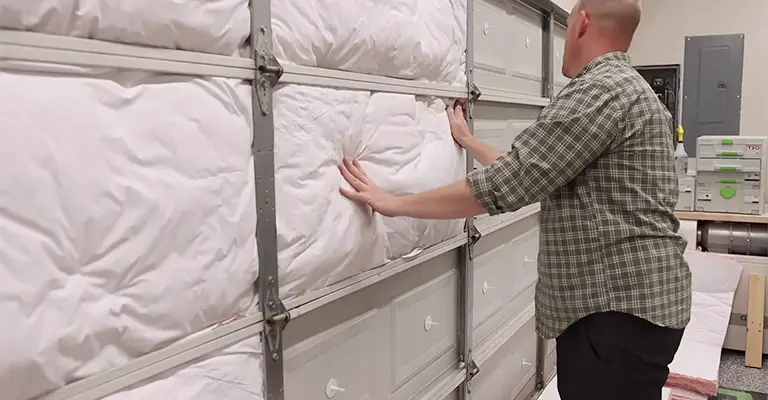The garage, once a simple shelter for vehicles, has evolved into a multifunctional space for various purposes beyond parking.
As the garage’s role expands, so does the consideration for its comfort, energy efficiency, and overall utility.
It’s not just a place to park anymore; it’s your workshop, your gym, your storage space.
But here’s the kicker: It’s either freezing in winter or hotter than a sauna in summer. So, you wonder – Could insulating that garage door be the solution?
Do Insulated Garage Doors Really Make A Difference?
A garage door is usually one of the largest spaces in a home that is not insulated. The metal barriers of an uninsulated garage can easily permeate extreme temperatures during the hot summer months and the cold winter months.
Additionally, heat transfer can significantly affect energy costs, leaving you with unused space at the expense of your budget. It’s relatively easy to insulate your garage door on your own, and it’s inexpensive to do.
You can dramatically improve your garage door’s insulation properties in just a few hours by using the EPS garage door insulation panels readily available at many big box hardware stores.
Save or Skip: Deciding on Garage Door Insulation’s Worth
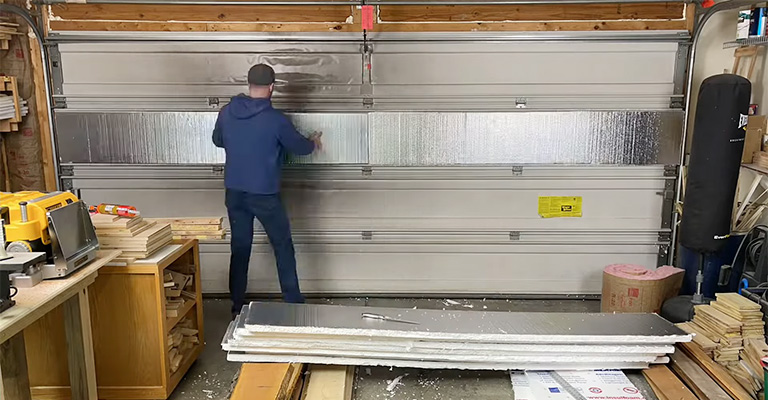
In attached garages, garage doors are often viewed as weak links in the home’s thermal envelope. Most homes open their garage doors several times a day, exposing their interior walls to the elements.
Since garage doors open and close like this, they are difficult to seal and insulate properly. The materials cost of insulating a garage door thoroughly can often be more than the energy savings you’ll gain unless the garage door is rarely used.
Many people still believe that adding insulation to the garage door is necessary and warranted. In a few cases, this may be true.
1. An Insulated Garage Door Slows Heat Transfer
In your garage, EPS foam insulation supports more comfortable temperatures when installed as garage door insulation.
As a rigid insulation with the highest R-value per dollar, EPS foam can significantly reduce heat transfer to and from your garage.
When you install EPS foam insulation, your garage will be less affected by external temperature changes.
Insulating a garage door is estimated to lower garage temperature by 20 degrees.
It is essential to have a comfortable garage temperature throughout the year as it increases its functionality and helps reduce energy and operating costs.
2. Garage Door Insulation Reduces Noise
It is common for garages to be the noisiest rooms in the house because their uninsulated garage doors let sound waves pass easily through their thin walls to get into the house.
The distractions can be unpleasant, not to mention sapping the pleasure of working at home. You can immediately improve the sound-dampening properties of your garage door by insulating it with EPS foam.
It gives you a more private working space and peace of mind that your DIY projects will not disturb the neighbors.
Insulating Garage Doors: Practical Techniques for Homeowners
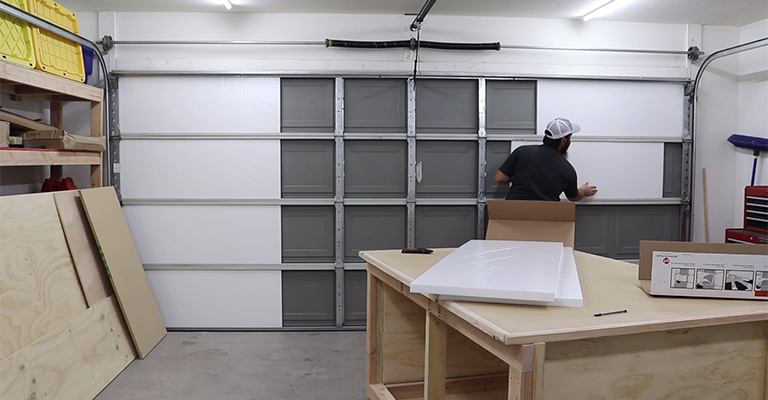
The garage door is regularly opened and closed, with several places where it hinges or folds. Depending on the type of insulation, some methods may not last as long as the door continues to function. The insulation can be flaking or pulling apart.
Among the insulating methods that you can try, perhaps as a temporary fix, are the following:
Fiberglass insulation batts: the least expensive type of insulation used primarily for doors on the inside.
Reflective insulation: rigid boards covered with silver foil, used in hot climates to deflect heat.
Cellulose insulation: Sprays onto the garage door; provides superior performance to spray foam; however, it is the most expensive of the options.
Spray foam insulation: used on garage doors but is not the most effective method; sometimes used on roof sheathing to improve the R-value of attics.
Foam board insulation: lightweight, rigid panels designed to provide high levels of insulation.
Should You Insulate Your Garage Door?
In the garage, where you store cars and other items, you will likely be better off leaving the door alone and insulating the ceiling and walls shared with the house.
The garage door and other garage components might need insulation if you use it as a living space. It is essential to make your decision based on your lifestyle and needs.
New Insulated Garage Doors
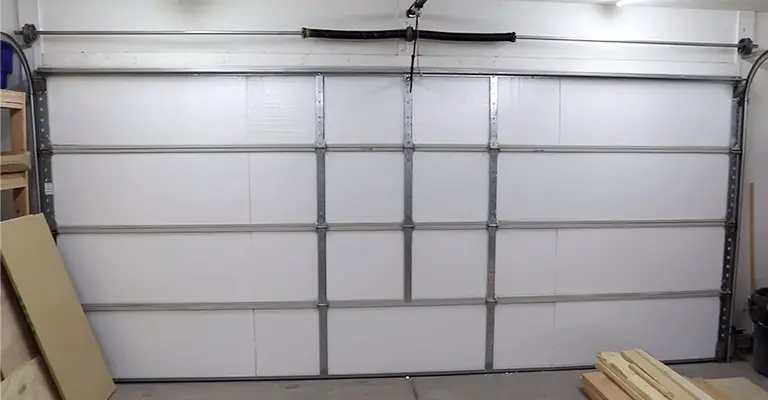
You’re better off purchasing an already-insulated garage door if you’re looking for an energy-efficient door.
You’ll save energy if you choose a fiberglass door with a foam core instead of a metal door, which conducts heat and cold efficiently.
If you plan to replace your garage door, consider an insulated model.
It probably isn’t economically feasible to purchase an insulated garage door just to save energy.
Insulate the Rest of the Garage Instead
The insulation on garage doors is of limited value in any case, given that other garage areas are similarly prone to energy losses.
You probably have a slab floor in your garage, which is uninsulated and is a major source of energy loss. There is constant transference of energy within concrete walls in your garage, as well.
Taking the time and spending the money to insulate your garage doors will only have a limited impact on your utilities since thermal energy is still lost elsewhere.
The best way to insulate the attached garage is to focus your efforts on the boundary wall between the main house and the attached garage rather than the garage door and other components.
Despite fluctuations in garage temperature, this won’t significantly affect your home’s temperature or raise your energy bills. You can do this in the following ways:
You should insulate the garage ceiling to stop the energy loss to the room above, which may be the attic or room above the garage.
You should add plenty of insulation to the garage wall that connects to the house.
Fill in all the gaps and cracks in the garage before insulating it by spraying low-expansion spray foam around the area and along any windows.
The Exception
Many contractors will recommend insulating the transfer points from the garage to the house, but you may also want to insulate the garage door and its walls and floor.
When your garage is used for living space rather than storage, then you may be heating or cooling the area anyway, which may not mean much use for the garage door.
Maximizing the R-value of the walls, floors, ceiling, and garage door in this case is advisable. As well as attached garages, there can be detached garages that are separate from the house.
To achieve high energy efficiency in a detached garage, you should make every aspect as energy efficient as possible.
According to many garage door installers and insulation companies, R-18 garage doors can keep the garage space about 12 degrees warmer in winter and 25 degrees cooler in summer.
Nevertheless, the cost of an energy-efficient double garage door ranges between $ 1,500 and $2,000, so it will take a long time to save enough energy to cover the door’s cost.
Moreover, it makes sense for spaces where the garage door won’t open often to reduce energy consumption.
Garage Door Insulation Kits
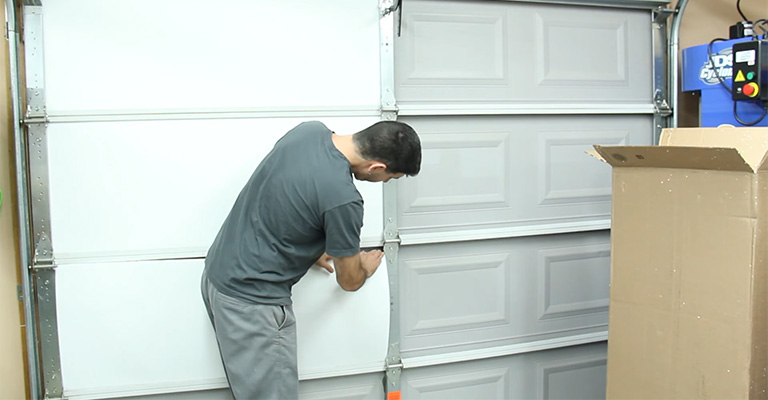
Another option is to insulate the garage door with a garage door insulation kit, available at home improvement centers where the garage will be converted to living space. A kit can usually be found in two forms.
An R-8-rated fiberglass batt kit used in a garage door will provide a decent amount of insulation; two kits will cover an 18-foot garage door.
Typically, this type of insulation is applied to the inside surface of the door with tape. You can purchase rigid foam panels made from expanded polystyrene (EPS) for another option.
To install the panels, the panels are cut to length and snapped into spaces between the horizontal rails on the door panels. In general, this type of kit provides an R-4 insulating value.
Air Sealing
Most people think of improving energy efficiency in terms of adding insulation, but the reality is that a significant degree of heat loss occurs because of air gaps where drafts arise.
Insulating a garage will be of limited value if door gaskets, window weatherstripping, and other air gaps are still providing places for air to flow. Permanently seal these areas when addressing a garage’s energy efficiency.
Will Insulating Your Garage Door Make a Difference?
In most cases, the difference in insulating a garage door isn’t worth it. Instead, insulate the entire garage. These areas are also a source of energy transference from the floor to the walls and the ceiling.
So, even if you take the time and money to insulate the door but neglect to insulate these areas, you may not see an improvement in your energy costs.
A more practical solution would be to insulate the entire garage—particularly insulating any walls that connect the garage to the rest of the house.
This means insulating the ceiling to prevent energy loss to the space above, insulating the border between the garage and the home, and even protecting the floor and windows to eliminate any air gaps.
And, of course, while doing this, taking the time to insulate the garage door itself may be worth it.
Ultimately, you’ll have to make this decision based on your lifestyle and needs. The style of your garage, the use you give this space, and the temperatures in your area will help you determine if it’s worth it to insulate your garage door.
Final Words
Your garage door is just one of the places that can benefit from being insulated. Heat enters and escapes through attics and doors, contributing to unstabilized air temperatures inside the house and unnecessarily high energy costs.

